Manitou Mattoc
Travel Options: 110 to 150 mm in 10 mm increments (internally adjustable)
Wheel Sizes: 27.5’’ and 29’’
Available Offset Options: 37 mm and 44 mm (27.5’’); 44 mm (29’’)
Stanchions: 34 mm
Stated Weight:
- Mattoc Comp: 2,020 g
- Mattoc Expert: 1,760 g
- Mattoc Pro: 1,750 g
MSRP:
- Mattoc Comp: $600
- Mattoc Expert: $825
- Mattoc Pro: $1,050
Blister’s Measured Weight: 1,793 g (Mattoc Pro 29”)
Reviewer: 6′, 170 lb / 183 cm, 77.1 kg
Bolted To: Guerrilla Gravity Trail Pistol, BTR Ranger, Guerrilla Gravity Smash
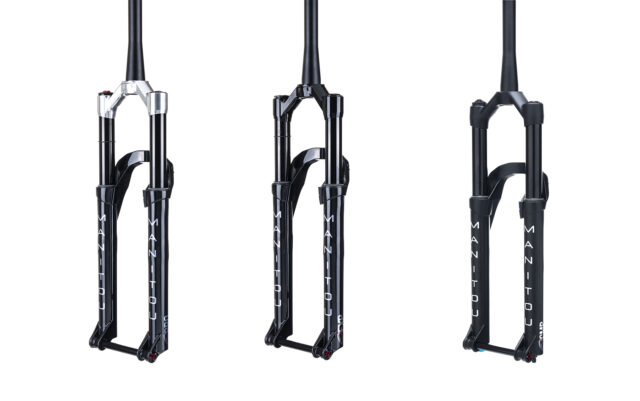
Intro
The Manitou Mattoc had been around for a very long time, and while the prior-generation fork had gone through a number of smaller updates over the years, Manitou’s mid-travel Trail fork hadn’t had a full redesign in quite some time. But that’s all changed because Manitou has launched a new iteration of the Mattoc with changes to just about every part of the fork, including a new chassis, new dampers, tweaked spring designs, and more.
Design
The new Mattoc retains the reverse-arch lowers and 34 mm stanchions of its predecessor, but the chassis is all new and Manitou says that it’s 30% stiffer than the prior iteration. The axle is, unsurprisingly, a 110 x 15 mm Boost design, with a post-mount brake mount for a 160 mm rotor (maximum allowable rotor size isn’t stated) and a 1.5’’ tapered steerer tube. Tire clearance is stated at an ample 67 mm (2.64 in) wide. The prior-generation Mattoc routed the brake hose down the back side of the fork leg, but the new one adds a more conventional (and in my opinion, cleaner) bolt-on guide on the front of the non-drive-side leg, with a zip tie anchor on the arch sticking around for adherents to Manitou’s older setup.
Manitou is talking a big game about the versatility of the Mattoc, saying that it’s light enough for XC race use, but beefy enough for “light enduro” duty; at a claimed weight of 1,750 g (Mattoc Pro 29’’), it’s lighter than a Fox 34 Grip2 (1,890 g) and RockShox Pike (1,943 g) so it’ll be interesting to see how the Mattoc fares under more aggressive riding in particular. The burlier Manitou Mezzer is impressively stout for its weight, which perhaps bodes well, but we’ll just have to get on a Mattoc (supposedly soon) to find out more.
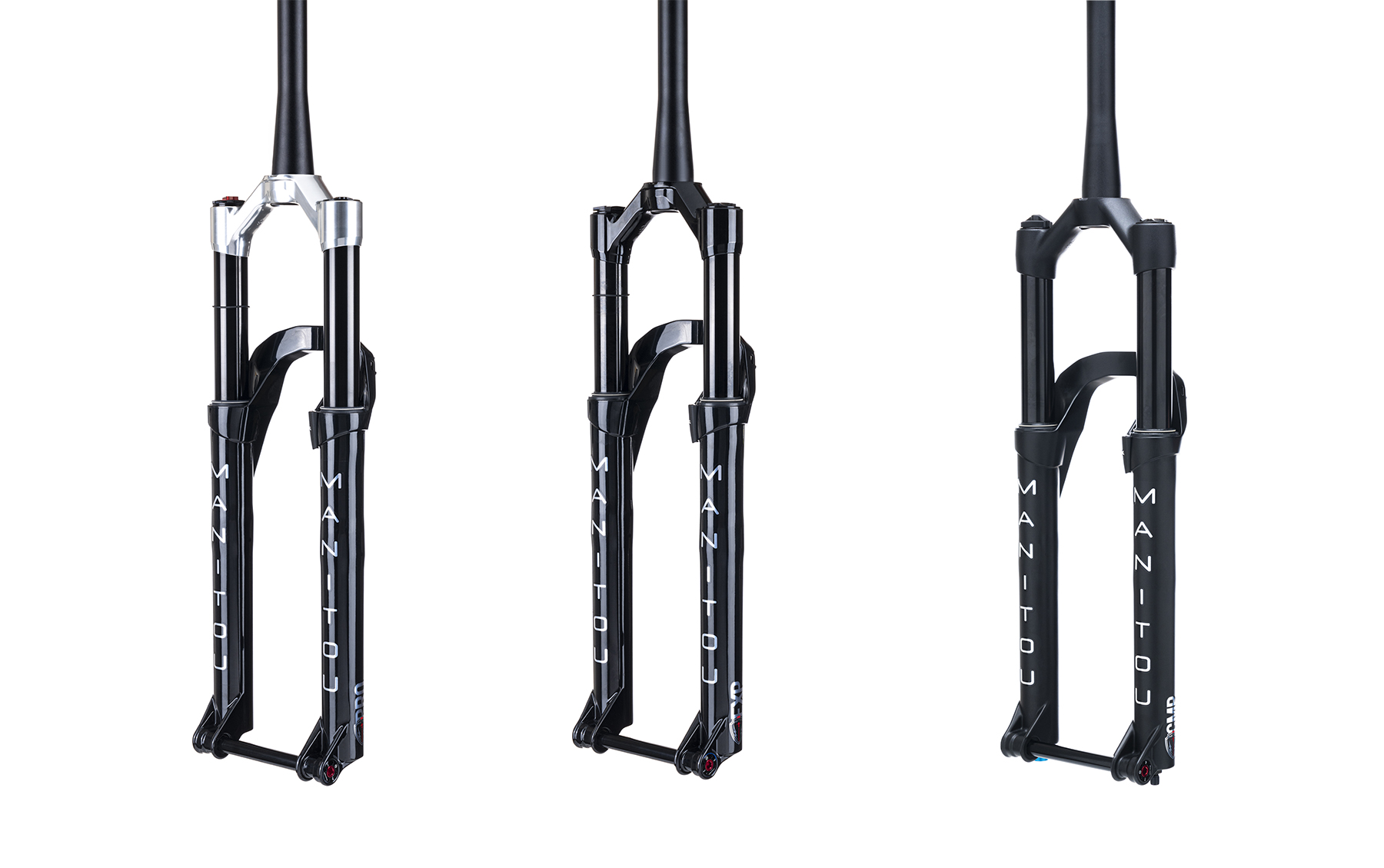
Versions
As per usual for Manitou, the Mattoc is available in three different versions with different spring, damper, and chassis designs. And while the Comp, Expert, and Pro versions differ substantially in terms of their internals, most of the parts can be swapped between the various Mattoc trim levels — and the Circus and Mastodon dirt jump and fat bike forks as well — to upgrade a lower-tier fork or just customize a given fork as desired.
Mattoc Comp ($600):
- Chassis: 6000-Series Aluminum stanchions
- Spring: Expert Air w/ IVA
- Damper: ABS+ (adjustable rebound and low-speed compression)
Mattoc Expert ($825):
- Chassis: 7000-Series Aluminum stanchions
- Spring: Expert Air w/ IVA
- Damper: Open cartridge TPC (adjustable rebound, three-position compression w/ Open Mode low-speed compression adjustment)
Mattoc Pro ($1,050):
- Chassis: 7000-Series Aluminum stanchions
- Spring: Dorado Air w/ IRT
- Damper: Sealed cartridge MC2 with hydraulic bottom-out (adjustable rebound, high- and low-speed compression)
The Mattoc Pro gets a shiny polished silver crown, while the Expert chassis is a bit less flashy in black, but functionally identical. The Comp version uses straight-wall 6000-series aluminum stanchions in place of the butted 7000-series ones on the higher-end models, which contributes to a stated ~260 g weight penalty for that version; we’d assume that not all of that weight difference is coming from the stanchions (the dampers also differ) but Manitou doesn’t break out those details.
The Mattoc is available for 29’’ wheels with 44 mm of offset, or in a 27.5’’ version with your choice of 37 or 44 mm offset. Manitou is quick to point out that not only are some adults better served by 27.5’’ wheels (and there are still some great mid-travel bikes that come with them) but also that offering a 27.5’’ version of the Mattoc gives them a high-end option for a lot of larger-sized kids bikes, too. Manitou also has a new Junit fork out alongside the Mattoc, which is a high-end offering for 24’’ and 26’’ wheel options for smaller kids’ bikes — a market niche that the bigger players have been ignoring, and is cool to see being filled.
At 542 mm axle-to-crown height for the 29’’ version configured with 130 mm of travel, the Mattoc is right in line with the Fox 34 (544 mm) and RockShox Pike (541 mm); the 27.5’’ version of the Mattoc is 20 mm shorter than the 29er at a given travel setting, and changing the travel, of course, changes the axle-to-crown height in the same 10 mm increments as the travel change itself. Manitou also offers a bolt-on fender for the Mattoc. The Pro and Expert versions also feature Manitou’s “Trail Side Relief” bleeders to vent built-up air pressure in the lowers.
Springs
Manitou offers two different air spring versions in the Mattoc, with the top-tier Mattoc Pro getting their IRT air spring, and the Expert and Comp using the same IVA one. All are internally adjustable from 110 to 150 mm of travel in 10 mm increments by adding or removing spacers to the air shaft (which are included with the fork). Manitou says that the spacers have been revised to better compensate for the resulting changes in negative spring volume than in the prior-generation Mattoc, but the system is conceptually similar to that fork (and the Mezzer).
IRT Air (Mattoc Pro)
The IRT air spring used in the Mattoc Pro is conceptually very similar to that used in the Mezzer and Dorado Pro but lightly reconfigured for the smaller Mattoc chassis. In short, it’s a dual-positive air spring design, the likes of which we’ve seen in a bunch of forks from Manitou, Ohlins, and EXT over the years, as well as EXT’s new Aria rear shock.
The way it works is fairly straightforward. Like most modern air-sprung forks, there’s a main positive air chamber with a negative chamber opposing it. Instead of using a dimple machined into the stanchion to equalize pressure between the two at top-out, the IRT spring equalizes pressures between the main and negative chambers when a shock pump is attached to the valve, but the end result is conceptually similar. Manitou argues that their system makes for a slightly more supportive fork since there’s no “flat spot” in the spring curve while the main air piston moves over the equalization dimple; it also allows for Manitou’s spacer-based system of changing travel, which isn’t possible in forks that use a dimple for negative chamber equalization.
[If you could use a refresher on what all that stuff about positive and negative springs means, check out the “Design” section of our Vorsprung Secus review, which covers the subject in detail.]
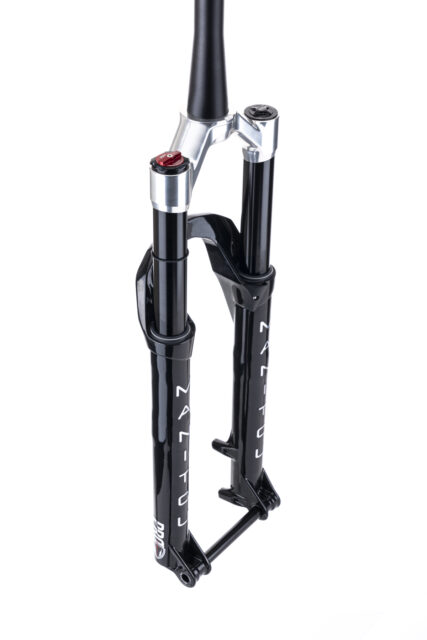
That’s all pretty normal, but then Manitou stacks a second positive air spring chamber, called the IRT (for “Infinite Rate Tune”), on top of the main air spring. The IRT chamber is filled by a second valve at the top of the fork leg and should be pressurized before the main chamber to ensure a consistent and repeatable setup.
The IRT chamber is pressurized to a substantially higher pressure than that of the main spring, and they’re separated by a floating piston that slides on a shaft, which limits how far into the fork leg the piston can move. When the fork starts to compress from top-out, only the main chamber compresses initially, until its pressure builds to equal that of the IRT chamber. At that point, the piston separating the two begins to slide, compressing the IRT chamber in proportion to the main one, so that their pressures remain equal.
This means that, from that inflection point forward, the main and IRT chambers effectively behave as one larger one, and the spring rate then ramps up more slowly due to that larger total air volume. The idea is to make an air spring that offers increased midstroke support, due to the more aggressive ramp-up of the main chamber earlier in the stroke, without making the spring continue to ramp up as aggressively, making it difficult to use full travel, or resulting in harshness as the spring rate ramps up to the moon. And by varying the relative pressure in the main and IRT chambers, you can change where in the fork’s stroke that inflection point occurs, and thereby make significant changes to the overall shape of the spring curve, and with it, the fork’s feel and performance.
The prior-generation Mattoc received an update that included an optional IRT spring part way through its run, but we never reviewed that particular iteration. We have, however, been quite impressed with the IRT spring in both the Mezzer Pro and Dorado Pro, and are looking forward to seeing how it pans out in a shorter-travel configuration.
IVA Air (Mattoc Expert & Mattoc Comp)
The IVA (“Incremental Volume Adjust”) spring used in the Mattoc Expert and Comp is a bit more conventional — while it uses the same system for changing travel and equalizing negative spring pressure as the IRT spring in the Pro, the IVA version replaces the IRT assembly with a static piston that allows for the adjustment of the total positive spring volume, similar to more typical air volume spacers. Instead of adding or removing volume spacers to change the air spring volume and therefore the total amount of progression, the IVA piston can be set to one of three positions to produce different spring volumes. The result is functionally identical to that of normal volume spacers; IVA is just a different way of implementing the same idea without needing to add or remove parts.
In the Mezzer and Dorado, the main piston in the IRT and IVA springs is actually identical, so you only need to swap in the upper IRT assembly — which can be done in just a few minutes, without removing the fork lowers — to convert an IVA-equipped fork to an IRT one. We’d assume the same is true for the Mattoc, especially given what Manitou is saying about the modularity of the new fork, but we’ll confirm with them and report back.
Dampers
Though the Mattoc Expert and Comp share spring designs, all three tiers of the Mattoc get different dampers. And to reiterate, the different dampers can be swapped between the various Mattoc trim levels as desired.
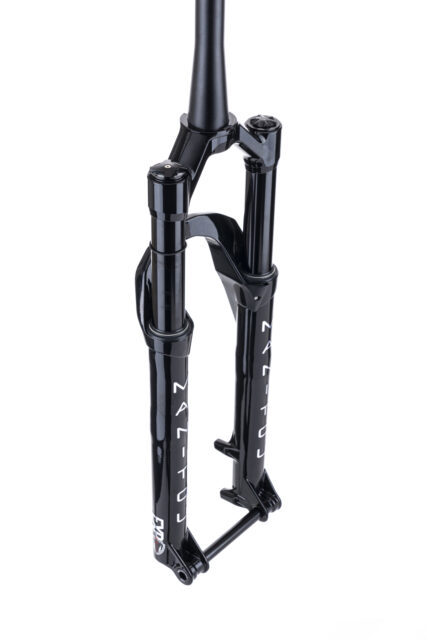
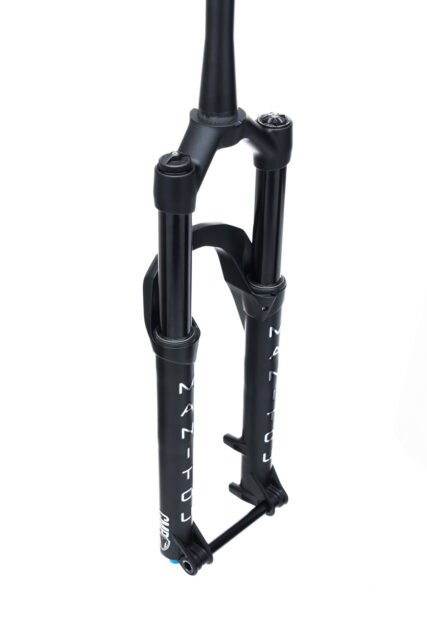
MC2 w/ HBO (Mattoc Pro)
The MC2 damper used in the top-tier Mattoc Pro is a slimmed-down version of the damper used in the Mezzer Pro Enduro fork — a sealed-cartridge design that uses a bladder for oil-volume compensation, with a pressure-relief valve to keep the damper intact if it gets overfilled. The MC2 damper has independently adjustable low- and high-speed compression, plus adjustable rebound. It also features a hydraulic bottom-out circuit that adds additional speed-sensitive compression damping in the final 30 mm of travel to help control and mitigate hard bottom-out events.
Manitou says that the sealed design helps with consistency over longer descents that put more heat into the damper, though it does make service a little more complicated since an additional step of bleeding all the air out of the damper is required. The MC2 damper in the Mezzer is quite straightforward to work on, though, and Manitou includes two bleed ports on it to connect syringes to make the job easy; we’d assume they’ve done the same on the Mattoc but will need to wait for our test fork to show up (we’re told it’ll be soon) to crack it open and find out.
VTT-6 (Mattoc Expert)
The Mattoc Expert gets a substantially different damper design — the open-bath VTT-6 offering, which features adjustable rebound plus a three-position compression lever with “Open,” “Trail,” and “Lock” modes, plus a finer low-speed compression adjuster for the “Open” mode. The VTT-6 damper also forgoes the hydraulic bottom-out circuit from the MC2 one in the Mattoc Pro.
ABS+ (Mattoc Comp)
The base Mattoc Comp gets a simpler open-bath damper with adjustable rebound and compression. It uses an entirely different design from the other Mattoc dampers, though the base Mezzer Comp and Dorado Comp both use a version of the same design, just reconfigured for their respective chassis.
FULL REVIEW
The Enduro-oriented Manitou Mezzer was my introduction to the world of dual-positive air-sprung forks, and while I’ve ridden a whole lot more of them in the years since, I’ve continued to be a big fan of the concept in general, and the Mezzer in particular. So when Manitou said they were giving their lighter-duty Mattoc fork an overhaul — and that a lot of the design details were adapted from the Mezzer — I was pretty excited to try one.
I’ve now used the new Mattoc Pro on a few different bikes and at a range of travel settings for much of the summer. While the Mattoc Pro that I’ve been riding looks a lot like the Mezzer Pro on paper, it serves as a good illustration of how much of a difference finer details of tuning can make on a suspension product. But I’ve also come around to thinking that the Mattoc is probably also a better product because it’s not just a slimmed-down Mezzer — they’re both very good forks, but for different intended uses and sorts of riders.
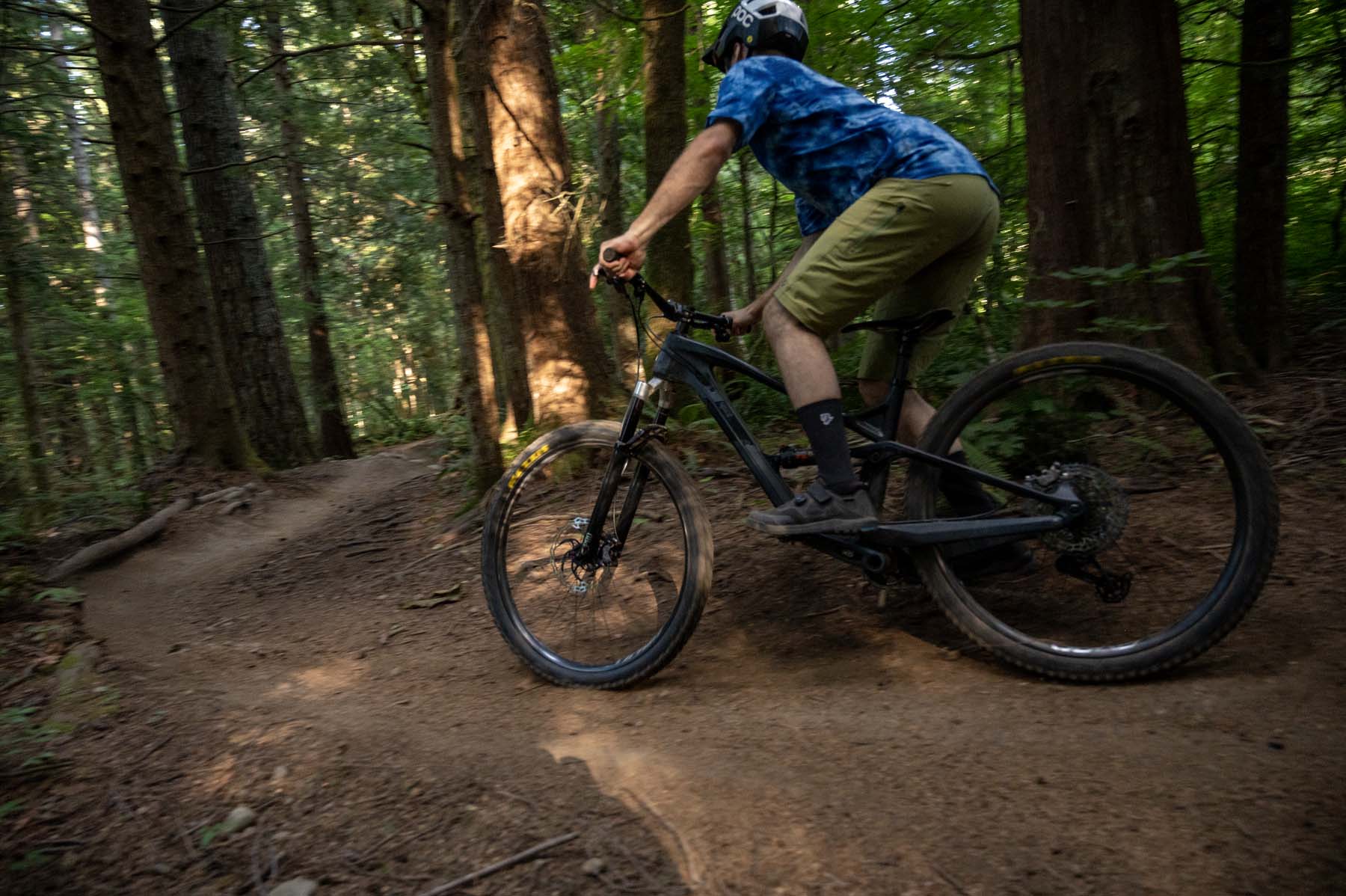
Performance
One of the standout features of the burlier Mezzer Pro is just how much support and composure it offers on steep, rough trails. This stems from the combination of its dual-positive IRT air spring — which principally increases midstroke support from the spring — and the damper tune, which is on the firmer side overall and does a notably good job of achieving relatively high levels of high-speed compression damping without feeling especially harsh or spiky on sharp hits.
Despite its shared damper and spring designs, the lighter-duty Mattoc Pro feels like it’s been toned down a bit, with a lighter compression damping tune and a spring arrangement that still offers good midstroke support but seems to place a greater emphasis on initial sensitivity and a more plush ride overall. The Mattoc has better small-bump sensitivity than the Mezzer, and while there’s a relatively wide range of tuning available from the air spring, the Mattoc doesn’t feel as aggressive as the Mezzer in terms of its ramp-up through the middle part of the stroke. The Mattoc’s level of support on very steep trails when being pushed hard is a clear notch down from the Mezzer’s, but the Mattoc is also more plush and feels more forgiving on mellower trails and more moderate speeds, where it’s simply not being loaded up as aggressively.
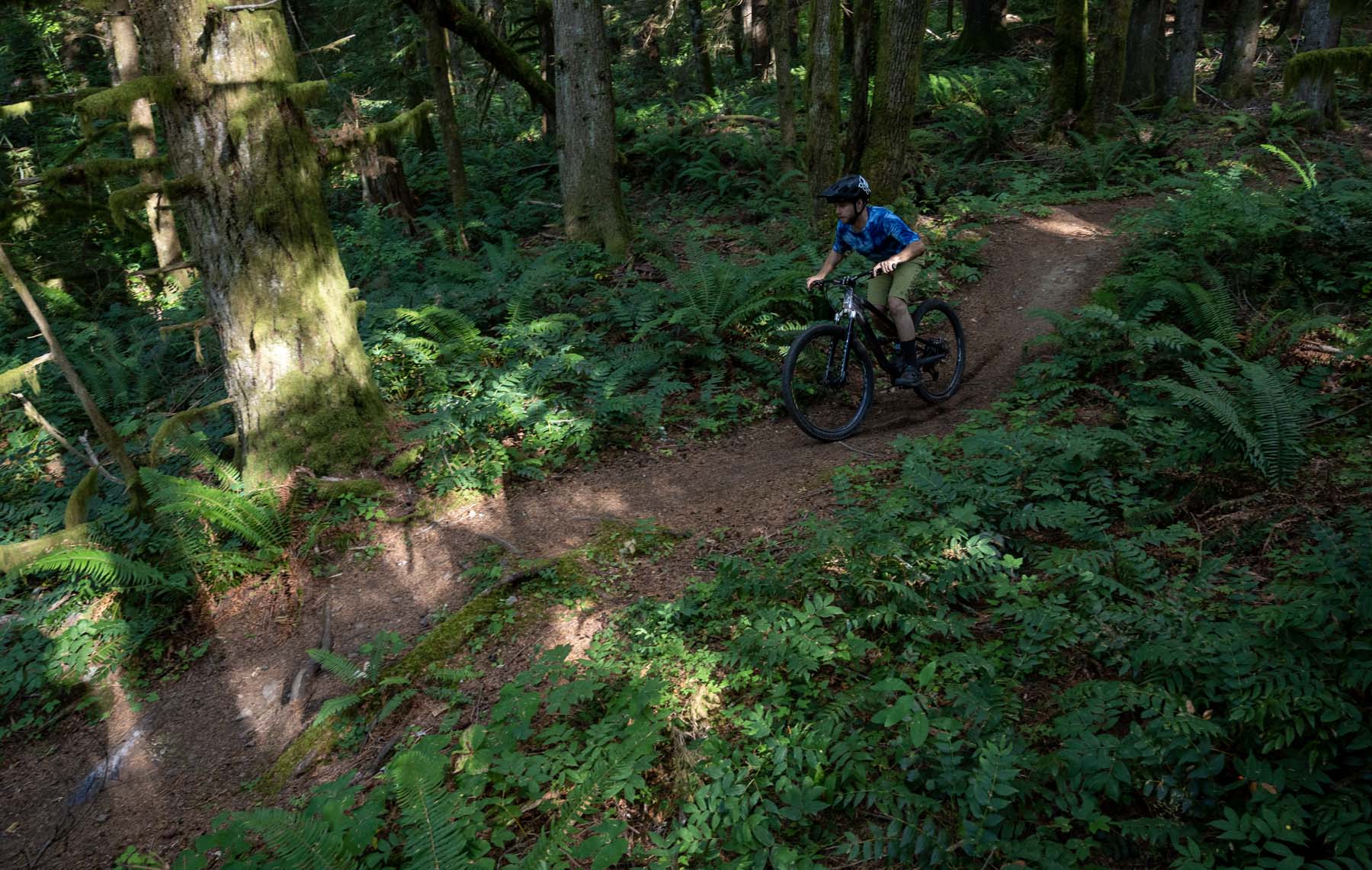
I think that makes a lot of sense. The Mattoc is the lighter-duty Trail bike counterpart to the more Enduro-oriented Mezzer, but there’s substantial overlap in the travel ranges that they can accommodate. By separating their performance by more than just a tradeoff in chassis stiffness vs. weight, Manitou has an option for more people in their lineup. There are riders for whom the lighter chassis and lighter damping are going to be beneficial — even at the Mattoc’s maximum 150 mm travel. Other folks would clearly benefit from the extra beefiness of the Mezzer, even on a smaller bike with the Mezzer set to 140 mm travel. (Manitou doesn’t officially support it, but I’ve run a Mezzer down to 130 mm of travel and that works fine, too; since the Mezzer and Mattoc use spacers to adjust the travel, you just need to add another one.)
It’s probably telling that Manitou’s setup guide for the Mattoc recommends much closer air pressure settings for the main and IRT air chambers than they do in the Mezzer. Though the designs are conceptually pretty much the same, the tweaked volumes of the three chambers (including the self-adjusting negative one) make for notably different tuning needs, and in turn, on-trail feel. Manitou’s detailed setup guide got me pretty close, though I wound up running a little more IRT air pressure than their general recommendations in all the travel configurations that I tried (130, 140, and 150 mm). The general tradeoffs in changing the IRT pressure relative to the main chamber in other dual-positive air forks apply here, too, though I found the Mattoc to be a bit less sensitive to small changes in IRT pressure than the Mezzer. Running more IRT pressure increases the amount of midstroke support and overall progression. Reducing IRT pressure softens the midstroke and makes the middle portion of the travel feel more plush and compliant, even when making small increases to the main chamber to maintain a similar level of overall stiffness.
(Aside on tuning dual-positive air springs: Increasing the pressure in one chamber while leaving the other alone makes the fork stiffer overall, and vice versa; changing just the main chamber has more of an impact on the early part of the stroke, whereas the IRT one comes into play later in the travel. The greater the difference in the IRT pressure relative to the main chamber, the more midstroke support is on offer, while running a smaller difference in the two pressures results in a more plush feel through the middle part of the travel.)
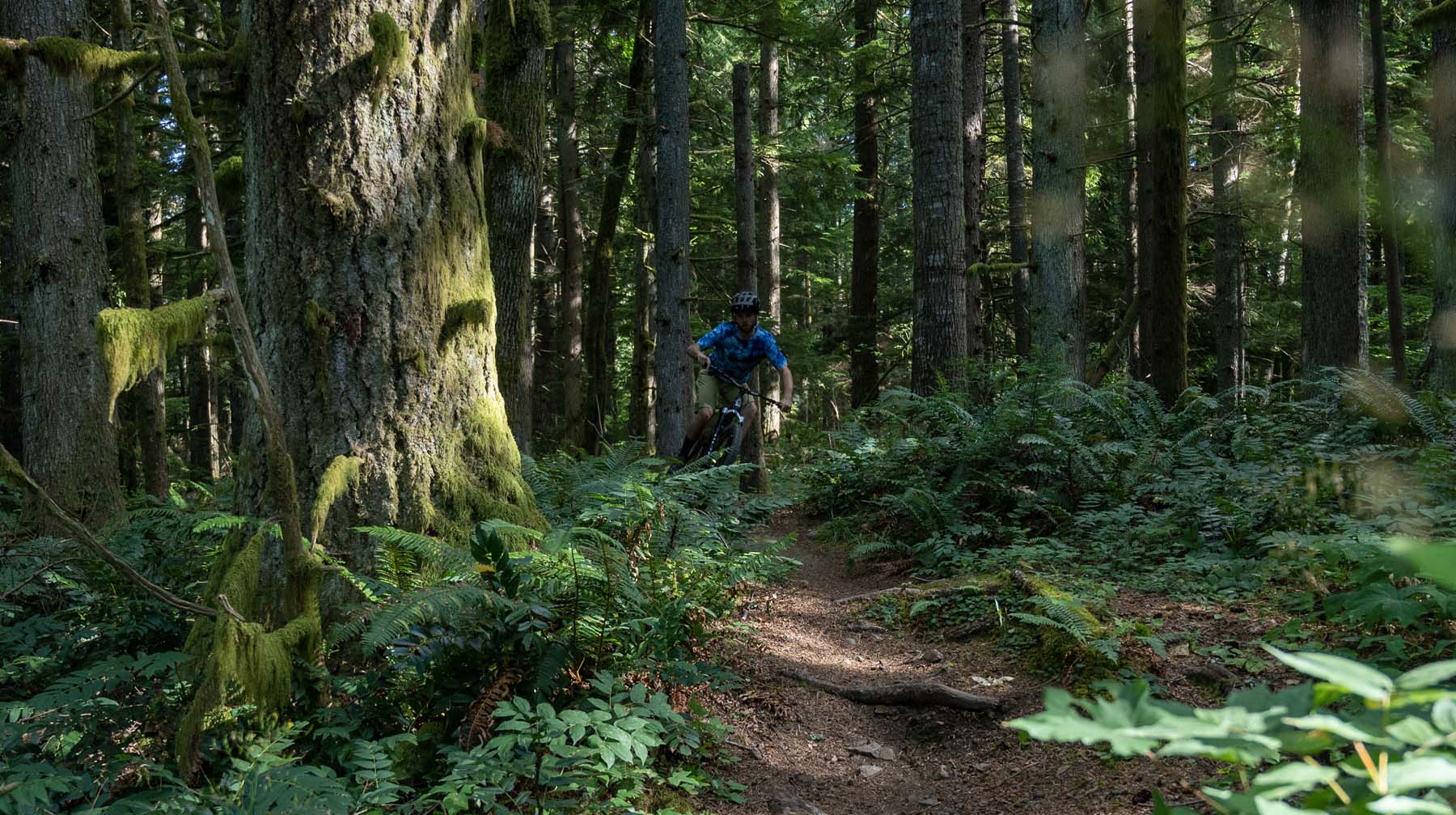
Like the Mezzer, the Mattoc isn’t a particular standout in terms of outright stiffness when compared to some other forks at the higher end of its travel range, but it starts to look a lot more impressive when you think about it in terms of stiffness-to-weight ratio. Comparing all three at 140 mm of travel (generally, a given fork gets less stiff as you increase its travel setting), the Mattoc feels very close to the Fox 34, despite being about 100 grams lighter; the RockShox Pike is a notable step up from the Mattoc and Fox 34 but weighs another ~50 grams more than the 34. Neither the Fox 34 nor the Pike go up to the Mattoc’s max travel of 150 mm; the relevant comparisons in Fox and RockShox’s lineups, the 36 and the Lyrik, are both much heavier and more stout than the Mattoc. The Mezzer is a little stiffer than both the Fox 36 and the Lyrik, but it’s the far more apt comparison to the 36 and Lyrik from Manitou’s lineup.
In terms of suspension performance, the Mattoc Pro once again feels like a closer comparison to the Fox 34 Grip2 than the Pike Ultimate or Select+ (I haven’t been on the Select or base versions of the 2023+ Pike yet), though it’s far from a perfect one-to-one match. The Mattoc is less emphatically supportive than the Mezzer, but the Mattoc’s spring still feels more supportive (and less super-cushy) through the middle part of the travel than the Fox 34’s spring. It’s also easier to make the 34 very progressive deeper in the stroke (by adding volume spacers) without making wild changes to its behavior in the rest of the travel range than it is with the Mattoc, though I’d argue that probably isn’t an especially good tuning goal for most folks anyway. The compression damping tune on both forks feels relatively light — at times, I’ve run the high-speed compression fully closed on both — and folks wanting to run the Mattoc with notably firm compression settings are likely to need to do some custom re-tuning of the damper to get there.
The current-generation RockShox Pike feels like a generally beefier fork than the Mattoc in a lot of ways. It’s substantially heavier than the Mattoc but gets a corresponding increase in chassis stiffness and precision to go with that, and its damper tune is firmer, especially at the more damped end of the high-speed compression range. The Mattoc’s air spring has a slight edge in terms of small-bump sensitivity and smoothness, but the two aren’t far off, and they’re relatively close in terms of midstroke support as well.
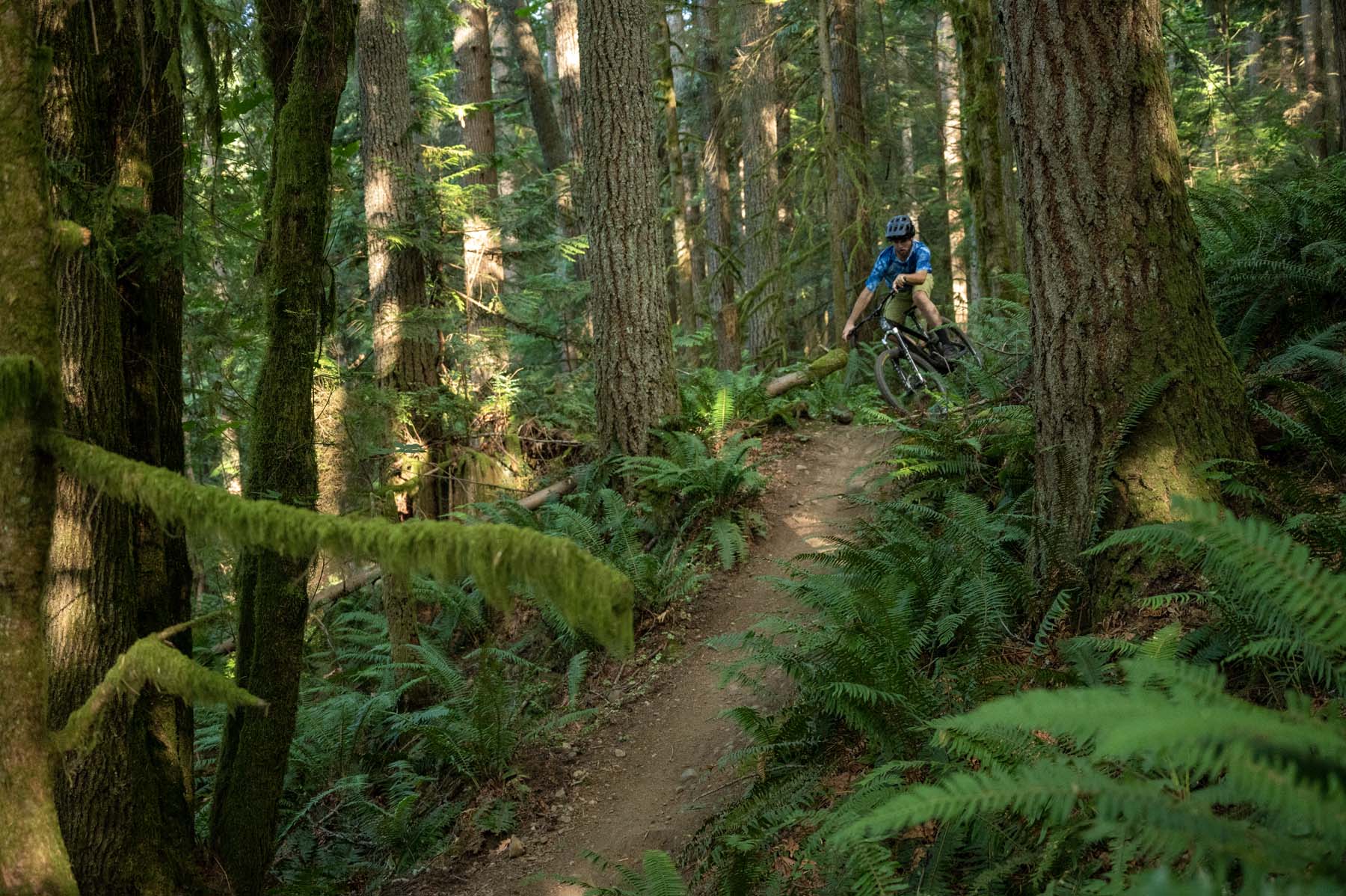
The Öhlins RXF34, on the other hand, feels like an emphatically more XC-oriented fork (and accordingly tops out at 130 mm of travel). It’s actually pretty close to the Mattoc in terms of both weight and chassis stiffness (the Mattoc is probably slightly stiffer, just not by much) but the RXF34’s spring and damper tuning feels oriented more toward providing a firm pedaling platform and adequate bottom-out resistance, with less of an emphasis on small-bump sensitivity and midstroke support. The RXF34 makes a lot of sense as a marathon XC fork for folks who want a little extra travel but are still principally focused on covering ground efficiently; the Mattoc certainly could fill that role if called upon, but it feels like more of an all-round fork that puts more of a premium on actual suspension performance than pedaling efficiency and maintaining a firm platform to augment it.
Who’s It For?
The Mattoc Pro is an excellent fork to pair with all-round Trail bikes, particularly for folks who put a big priority on saving a bit of weight but still want a fork that offers very good descending suspension performance, rather than more XC-oriented features such as lockouts and the like. The Mattoc’s setup is maybe a little more involved than some of its competitors, but that slight added complexity — mostly the dual-positive IRT air spring — opens up tuning possibilities that more conventional spring designs don’t offer, particularly in tuning the level of midstroke support somewhat independently of the initial sensitivity. The Mattoc’s spacer-based travel change arrangement is also potentially a real selling point for folks who are interested in running the Mattoc on multiple bikes, or just experimenting with travel options without needing to buy a pile of different air shafts, too.
Heavier and/or more aggressive riders, especially those who are planning to run the Mattoc at the higher end of its travel adjustment range, should think about stepping up to the Mezzer instead — its increased chassis stiffness and firmer damper tune are likely to be real upsides for those folks. Conversely, lighter or less aggressive riders for whom the Mezzer would be overkill (especially those who’ve found its compression damping tune to be too firm) might well be happy with the Mattoc right out of the box.
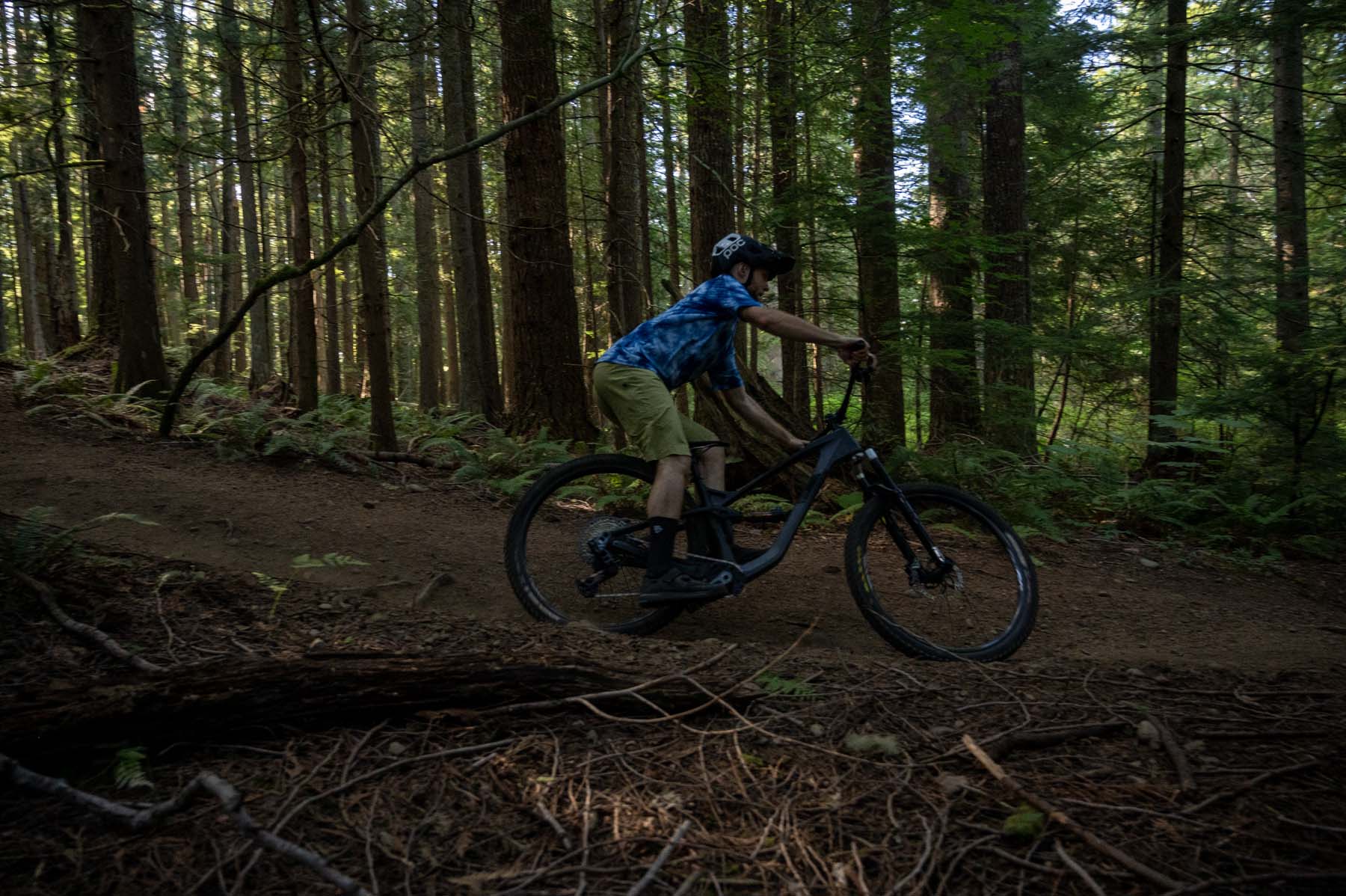
Bottom Line
I went into this review hoping that the Manitou Mattoc would feel just like a mini-Mezzer, and while it’s not exactly that, I’ve come around to thinking that’s a good thing. The Mezzer is an excellent Trail / Enduro fork for riders who prioritize a more supportive, composed feel over maximum compliance and plushness. Instead of just putting the same spring and damper into a lighter chassis (which those sorts of folks would likely tend to overwhelm), Manitou has done a great job of adapting those designs to make a more plush, more forgiving, and lighter Trail bike fork for the sorts of folks who find forks like the Mezzer to be overkill. And in that role, the Mattoc is excellent. For my preferences and the trails I frequent, the Mezzer makes more sense for more of my personal bikes than the Mattoc does, but that’s okay — and differentiating the two is absolutely a sensible move on Manitou’s part. The Mattoc is a very worthy competitor for forks like the Fox 34 GRIP2 in particular, especially if you like the sound of a more tunable air spring in that class of fork.

Nice write up. I’d take the Pro/Expert chassis with the ABS+ damper, which is superior for anybody shy of Richie Rude, and so darn simple.
Is this the fork that the Rock Rider WC team is using? Or is there something new and tasty in-store for us ?
Wondering what main to irt ratio you are using on the Mezzer and Mattoc. Small changes in pressure on the Mezzer do tend to really change the feel of the fork
This is a great roundup of the mattoc forks. I appreciate that the flagship gets most of the attention most of the time but I’d really like to understand how the expert and comp perform on the trail compared to the pro and the equivalent foxshox performance/select options.
I have both a mezzer and mattoc pro and like them both. Thinking about an expert or comp to fit on my secondary bikes.